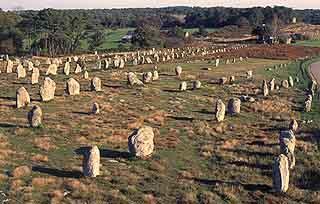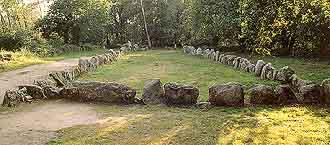- Home
- Megalithism in Morbihan
- Carnac
- From Kermario to Le Manio
The Kermario monument is the largest of all Carnac "groups of standing stones". It stretches over 1,100m and consists of over 980 stones. As in Le Menec, the monument lies south-west to north-east, but the lines are less regularly spaced. Scale model of the Kermario alignments between Le Manio on one side and the Kerloquet pond on the other.
At the western end, 10 lines cover an area 100m wide. Some of the blocks are quite large (over 3m high). Some 400m away, near the "Petite Métairie", there are 9 lines and further east, even fewer as a result of roads or quarries encroaching on the monument. The stones also become smaller and their layout is less clearly defined. The alignments peter out altogether after 850m, just before the Kerloquet reservoir.
The structure reappears on the eastern side of the pond and forms the "Manio group" of standing stones. This consists of 9 lines spread over a distance of 200m and a width of 45m. This part of the Kermario monument is sometimes regarded as independent from the main group. The stones continue over the recognisable hump of a tumulary mound marked by a large menhir set apart from the rest of the lines.
The group is no longer regular as some areas were destroyed over the centuries:
- the ancient settlements at the western end, studied by J. Miln in 1877, were no doubt responsible for the disappearance of the final enclosure,
- several fields were cleared of stones and cultivated west of the "Petite Métairie", living quarters and farm sheds were built inside the monument,
- quarries encroached on the northern lines, close to the old Kermaux windmill
- existing damage was worsened when an earlier road, winding close to the southern border of the monument, was used to enlarge the present-day D 196 road,
- at Kerloquet, a reservoir separated the monument in two.
Scale model of the Kermario alignments between Le Manio on one side and the Kerloquet pond on the other.
Lines of menhirs running down the Kermario hillock towards the Petite-Métairie (far in the distance, they run back up towards the Kermaux mill).
At Kermario, there is a remarkable concentration of adjacent monuments:
- at the western end, a passage grave, adjoins the probable site of a former enclosure,
- the Kercado dolmen is located further away, south of the eastern part of the monument,
- the five Manio mounds are located around the eastern part. The alignments cross over one of them, while another is completely worn flat and is only visible thanks to its enclosure made of small standing stones, the famous Manio "quadrilateral enclosure".
- The "Manio Giant" is Carnac's highest menhir (6.5m). It was re-erected by Z. Le Rouzic, and stands in a "last man in line" position, east of the alignments.
Le Manio quadrilateral enclosure was probably part of a levelled tumulary mound.
The "Manio Giant". Its corroded surface shows it used to be an outcrop used during the Neolithic Period.



